Late Summer/Autumn Lectures 2014
September 5, 2014 by admin
Filed under Garden Lectures
Friday, September 12
When: 10:30 am
Where: Grantham Town Hall, 300 Rte. 10 South, Grantham, NH
Monthly meeting of the Grantham (NH) Garden Club
Lecture: Shade Revealed: How to Garden Successfully in Low Light (Really!)
Thank you to the Grantham Garden Club for hosting this event.
Thursday, September 18
When: 6:00 pm
Where: The Whistler House Museum of Art, 243 Worthen St., Lowell, MA
This program is part of the annual Moses Greeley Parker Lectures series
Lecture: Shade Revealed: How to Garden Successfully in Low Light (Really!)
Thank you to the Moses Greeley Parker Lectures program and the Whistler House Museum of Art for organizing and hosting this event.
Monday, October 20
When: 7:00 pm
Where: Buchanan Center, Mansfield Public Library, 54 Warrenville Rd., Mansfield Center, CT
Combined meeting of the Garden Club of Windham and the Mansfield Garden Gate Club
Lecture: Shade Revealed: How to Garden Successfully in Low Light (Really!)
Thank you to the Garden Club of Windham and the Mansfield Garden Gate Club for hosting this event.
How (Not) to Pick a Plant
February 6, 2014 by admin
Filed under Garden Design, Perennials, Shade Gardening
Over the coming months I’ll be basing a number of blog posts, including this one, on material from my forthcoming book, The Shady Lady’s Guide to Northeast Shade Gardening. The official publication date is May 6, 2014. You can learn more about the book here, here and here.
When you pick perennial plants to put in your shade garden, how do you do it? Most people would start out by picking plants they like—and that’s where they’d make their first, and worst, mistake.
Huh? What? Surely I can’t be advising you to pick out plants you don’t like?! No, of course not. But think about this for a second. When you go shopping for a new car, do you just pick out the one you like the best? No—at least not if you’re like most of us. If that were all it took, we’d all be driving around in Ferraris and Lamborghinis. The problem with that approach is that most sports cars won’t do what most people need a car to do: get up a snowy hill on a winter day and deliver you to your job in one piece, or get enough miles to the gallon to not break the fuel budget.
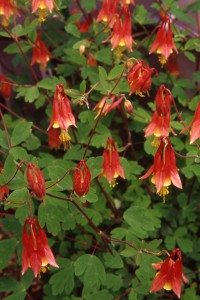
Flowers, flowers, we all like flowers—but there are many other important things to consider when choosing shade perennials.
In other words, we consider practical things. As weird an idea as this will seem to many people, you should do the same thing when you pick out plants—if you want your garden to look good with minimal effort and expense for the longest possible season.
Not all plants are equally good at doing that. In fact, for any given type of garden in any given region, only a small number of plants will give that kind of superior performance, in the same way that, in all likelihood, only a small number of cars will satisfy your criteria for budget and functionality.
So, what are the practical questions you have to ask when picking out plants? First, the more obvious ones:
• Is the plant cold hardy where I live?
• Does the plant prefer the conditions I can offer it?
It’s self-evident why these are questions you should ask first. It makes little sense to populate your perennial garden with plants that won’t be, well, perennial in your area. It also makes little sense to invest in plants that won’t be happy with the growing conditions you provide them. Matching plants to growing conditions is an essential part of the art of garden design. I’m not going to go into detail here about the fine points of that process; what matters is that you realize its importance.
What else do you need to ask yourself in order to pick the best perennials for shade? Here are a few more:
• Is the plant disease resistant?
• Is the plant prone to insect infestation?
• Is the plant unpalatable to deer and other potential browsers?
• Does the plant spread or seed aggressively?
• Does the plant typically go dormant before first frost?
• Does the plant have foliage that looks good all season long?
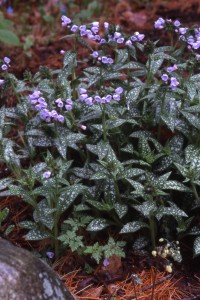
Powdery-mildew resistant Pulmonaria 'Roy Davidson'
The benefits of disease and pest resistance are obvious. Lungworts (Pulmonaria, see photo at left), for example, have unique speckled foliage that can brighten shady nooks and crannies, but most of them are prone to a disfiguring fungal disease called powdery mildew that leaves them coated with an unattractive whitish film. Luckily, some lungworts are resistant. If you buy only the resistant ones, you’ll be able to enjoy the beauty of disease-free lungworts, and you won’t have to expend extra effort to keep them that way.
It’s the same story for all the other questions above. By carefully selecting plants that aren’t palatable to most insect pests and browsing animals, you eliminate the need to take action to stop various critters from nibbling. Likewise, you reduce the need for work (and increase the percentage of your time in the garden devoted to enjoying it) by avoiding overly aggressive spreading plants.
Finally, as a general rule plants that perform well over a long season should be given priority over those that go dormant early or whose foliage declines in quality after flowering. Obviously, we’d all prefer a garden that looks full and good for the longest possible stretch of time.
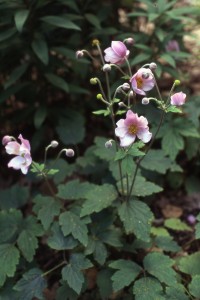
The long-flowering Japanese anemone cultivar 'Robustissima'
• Does the plant have attractive, prominent flowers? (Finally!)
• Do the flowers have a scent that’s nice, objectionable or simply absent?
• Do the flowers last a long time?
And there you have it: questions about flowers are in last place. Now, I want to clarify something. I understand perfectly why so many home gardeners give in to the temptation to fill their properties with plants having beautiful flowers. Beautiful flowers are lovely to look at—it’s as simple as that. The problem is that we don’t live in an ideal world. Flowers fade, and most perennials only produce flowers for two to three weeks every year under the best of circumstances. That’s not very long, so if you pick plants based on how well you like their flowers, you won’t get much bang for your buck.
I’m not saying that you should ignore a plant’s flowers when making choices. For instance, it is true that a small number of perennials will flower for a longer-than-average time, and can be worthwhile making room for these plants in your garden for that simple reason. One example is the Japanese anemone pictured above. I’m just saying that most of the time you should only be considering the flowers of plants that have passed muster in a lot of other ways first. Flowers should be your last consideration, not your first.
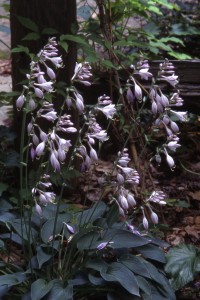
Cut these hosta flowers off? Not me!
In my next blog post, I’ll elaborate a little more on what makes a superior shade perennial and share a few examples.
My New Shade Gardening Book!
February 6, 2014 by admin
Filed under My New Book
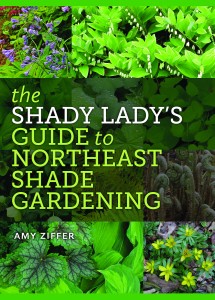 I am happy and proud to announce that my new book, The Shady Lady’s Guide to Northeast Shade Gardening from the University Press of New England is now available at bookstores and is shipping from online retailers!
I am happy and proud to announce that my new book, The Shady Lady’s Guide to Northeast Shade Gardening from the University Press of New England is now available at bookstores and is shipping from online retailers!
If you own a copy and are looking for the supplemental photos promised in the book, you can view the first batch (for Plants for Special Situations, beginning on page 189), by clicking here. Photos of Selected Shrubs (corresponding to text beginning on page 31) are on view here.
In the near future, in response to reader requests, I’ll also be adding a gallery of wider context garden shots to illustrate some of the shade garden design pointers I give.
I’d like to say a heartfelt “thanks” to readers who have posted favorable reviews in cyberspace, as well as to these respected folks, who read the book in the pre-print stage and had some kind words:
“Gardens—and gardeners—are rooted in place, so it’s a good idea to let people know where you’re coming from when you offer advice. Amy Ziffer’s The Shady Lady’s Guide to Northeast Shade Gardening puts it right out front. Hers is no one-size-fits-all tome, but a friendly and informative guide for gardeners who deal with trees, deer and unpredictable weather of the Northeast. Practical, detailed and realistic, Ziffer engagingly conveys the challenges and rewards garnered from years of hands-on gardening and close observation. Her depth of experience and conversational tone make this book the next best thing to being in the garden with her.”
—Karen Bussolini, garden author, photographer, speaker and eco-friendly garden coach
“Every Northeastern gardener needs to read this eyes-wide-open, tell-it-like-it-is book. Even if you don’t have shade now, follow the advice in this book and sections of your garden might someday bask in the shadows of luxuriant bedfellows. Get enlightened.”
—Tovah Martin, author of The Unexpected Houseplant and The New Terrarium.
“If you are tired of watching your lawn fade in the shady areas of your property, or have decided to fill those bare spots under your oak with beautiful perennials, Amy Ziffer can help. In her timely new book, the Shady Lady challenges a common misconception in gardening: that there are very few perennials that thrive in the shade. For gardeners seeking a nondestructive compromise between all native landscapes and those decorated only with exotic ornamentals, The Shady Lady’s Guide to Northeast Shade Gardening is a must read.”
—Douglas W. Tallamy, author of Bringing Nature Home: How You Can Sustain Wildlife with Native Plants.
I wrote the book because I saw a need for a different kind of book about ornamental shade gardening. While much good material has been written about the subject through the years, I saw the existing body of advice as incomplete.
What makes this book different from ones you’ve seen before? First, it’s specifically for gardeners in the Northeast. Because weather, growing conditions, and plant pests and diseases vary so much from region to region, you’ll find the best, most accurate gardening advice close to home. My book talks only about plants we Northeast gardeners can grow, organized to help you narrow down your choices even further by USDA Zone and growing situation.
Second, it takes a unique approach to plant selection and design. I’ve been frustrated by shade gardening books that simply list plants as if all of them were equally good. They’re not. My book evaluates plants based on their performance potential over the whole growing season as well as in specific light levels and under different growing conditions. They’re categorized to help you quickly find the plants most likely to contribute to a rewarding, successful landscape design for your unique property.
I introduce a concept I’ve used in my own design work for years: backbone plants. This is my own term for a select group of plants whose ornamental qualities are so superior to those of the bulk of plants that they should comprise the majority of most shade garden designs. By devoting most of your garden space to backbone plants, you’ll simplify the process of design and increase the chances of having a satisfying garden enormously.
Third, it discusses gardening honestly and frankly, as an endeavor that requires a real commitment of time and energy and has a real ecological impact—potentially good or bad. I strongly encourage increased use of the many fine native plants that have the potential to be superior shade garden performers. Conversely, I warn readers about the possible negative effects of using overly aggressive exotic plants they might one day wish they’d never grown. It’s my hope the book will stimulate a respectful dialogue—one that’s already going on—about whether and how we gardeners should leave a mark on our surroundings.
Thanks for your interest in my book! Here are links to a variety of resources where you can find out more about it and purchase it online (but please don’t forget about your hometown bookseller):
My Author page at the University Press of New England’s website.
My Facebook Author page. Please “Like” my page to help me promote it!
Indigo (Canada)
Breathtaking Bluebells
April 3, 2009 by admin
Filed under Shade Gardening, Spring Bloomers, Spring Ephemerals
Virginia bluebells (Mertensia virginica) are nothing less than the royalty of spring ephemerals. Large, showy, and colorful, they put on one of the very best spectacles of any spring blooming plant, with all the rich costuming you’d expect in the court of a queen.
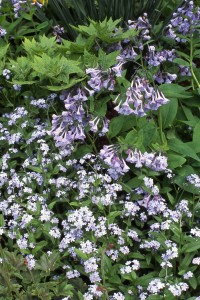
A May mêlée of Virginia bluebells and forget-me-nots
Virginia bluebells break ground very early in spring. Their tightly furled leaves look like tiny burgundy cabbages when they first emerge, but as they grow they quickly morph into medium green, fleshy oblongs that resemble the leafy green vegetable sorrel. Seemingly in no time they produce profuse clusters of dangling blue bell-shaped flowers on 18″ stems, blooming for several weeks in May. (They also come in a white-flowered form that is uncommon but possible to find.) Once flowering ceases, and almost before you have time to notice, they close up shop. Their leaves yellow rapidly, and the plants have gone completely dormant by mid June. They’ll spend the remainder of the year as inscrutable, seemingly dead but really just dormant roots nestled just below the soil surface. Incredibly, their entire aboveground life cycle is barely two months long.
The sheer rapidity of their growth and “demise” along with their large size and showiness make Virginia bluebells very border friendly. Their leaves do not need to hang around the garden for months to store enough energy to ensure flowering the following year. They put on their spectacular display and then vanish—a gardener’s dream!
Virginia bluebells are excellent interplanted with other blue-flowering plants such as perennial woodland phlox (Phlox divaricata). This phlox flowers just as the bluebells fade, so the segue from one to the other is seamless, and because the phlox spreads into a non-competitive groundcover, the bluebells will continue to arise through the mat of phlox foliage year after year. Biennial forget-me-not (Myosotis sylvatica) also makes a great companion, as shown in the photo above.
Virginia bluebells’ sky blue flowers are also an effective counterpoint to yellow daffodils. Gardeners with borders in both sun and shade can take best advantage of this artful duo, planting the sunny areas with clumps of daffodils and the shady ones with masses of bluebells. The result will be breathtaking!
Another natural companion is old-fashioned bleeding heart, whose brilliant pink or clean white flowers reach their peak simultaneously with those of Virginia bluebells, although the latter plant will go dormant months before the former. If you try this combination, use hostas, ferns or other late-emerging plants to fill in the areas occupied by the bluebells in May.
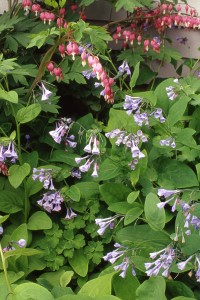
Bluebells and bleeding heart make a natural garden combination
Virginia bluebells spread readily by seed, moving outward from an original planting at a speed of a foot or two a year. In autumn, be careful working in the parts of your garden where bluebells are established, since it is so easy to dig into and accidentally destroy dormant roots at that time of year.
It’s not too late to have Virginia bluebells this year. Nurseries often stock them in April and early May since they’re one of the few plants that can be sold in full bloom at such a chilly time of year.
Sun/Shade needs: Half sun to moderately deep shade; full sun with adequate moisture
Hardiness: Zone 3
Size: 12-18″ tall; 8″ wide
Native status: Native to most of eastern North America, but not all of New England
Bloom times and other life cycle stats are accurate for northwest Connecticut. In milder areas all aspects of a plant’s life cycle may occur earlier in the year, and in colder areas, later.
March, 2010: Update! The good folks at GardenSMART took a shine to this article and reprinted it at their website. You’ll find this post (and many other interesting items) in the Articles section.
Spring Blooming Shade Plants: Hellebores
March 18, 2009 by admin
Filed under Perennials, Shade Gardening, Spring Bloomers
In a typical year, hellebores will be the first ornamental perennial to bloom in the Northeast. Although there are several species that can be grown in this region, especially in milder areas such as the coast and the lower Connecticut River Valley, one of the hardiest remains my favorite: Helleborus x hybridus (formerly and sometimes still known as Helleborus x orientalis).
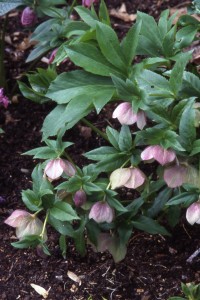
Helleborus x hybridus
Here in northwest Connecticut, hellebores send up their flower buds first, in March, before their leaves unfurl. As the month goes on, these succulent and tender looking shoots grow taller and taller, until they finally open up around April 1 to reveal clusters of 2″-wide, pendant blossoms. The species H. x hybridus is quite variable, with a range of subtle flower colors including creamy white, apple green, pale pink and burgundy. Its flowers often have striking speckled markings and prominent yellow anthers that are showy for about a week until the stamens fall off.
At first, hellebore flowers look a bit undressed because the plant’s leaves don’t come along until a few weeks later. When they do make their appearance, however, they are exceptionally attractive—leathery, glossy, palmate (arranged like fingers around the palm of a hand) and semi-evergreen.
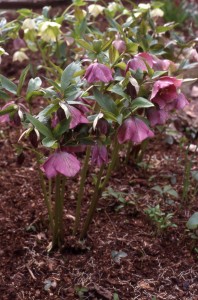
Hellebore flowers emerge before leaves
Everything about hellebores is long lasting. Instead of dropping off after 2-3 weeks, hellebore flowers slowly fade to a pale green or buff color in much the same way hydrangea flowers do. They look good (although subdued) right up to the point when the seeds mature and are dispersed, usually in the latter half of June. Deadhead them before that point unless you want seedlings the following spring. In most gardens, the leaves will remain disease free and unblemished all season long, and will still be looking good when the first snow flies.
Shade tolerance: High
Hardiness: Zone 5; other species may differ
Size: Medium sized, with a height and spread of 15-18″
Native status: non-native to any part of North America
Growing Tips
- Don’t cut back hellebore foliage in fall, even if you clean up the rest of your garden then. Why? Hellebores come up so early in the year, they are subject to damage from late frosts. These frosts won’t kill the plants, but they will kill the flower buds. As the plant’s shoots begin to emerge from the ground, last year’s leaves will provide some protection. After the new shoots have grown taller than last year’s leaves, you can groom them, cutting off the old foliage at ground level. Be careful not to accidentally cut off new growth—it’s easy to do. For a few more weeks after you groom them, it’s a good idea to keep some pine boughs or an equivalent handy to gently arrange over the new growth at night if a hard frost is in the forecast.
- Hellebores have to be several years old before they are mature enough to flower. A nursery plant in a 5-pint pot is probably only two years old, so don’t be surprised if it doesn’t flower its first (or even second) year in the ground. As long as the plant grows well and looks healthy, flowering should start when the plant is ready. A plant that fills a one-gallon pot should be old enough to flower its first spring after planting.
- H. x hybridus is often sold in a mix of undifferentiated colors. In other words, if the tag in the pot with your plant does not specify a flower color, but just says H. x hybridus, it could be any of the flower colors listed above. There’s no way to know which color you’ve got unless you buy the plant in bloom very early in the season and the plant is old enough to be blooming in the first place. In recent years, some growers have also offered hellebores in designated colors. I like the way the mixed colors look in the garden when hellebores are massed, but gardeners with color-theme gardens might prefer to purchase all of one kind.
- Hellebores have no special needs, but they don’t like excessive moisture. If put in exceedingly dank locations or planted in soils that drain poorly, rot of the crown may result.
- Hellebores self-sow moderately. Their seeds are large and heavy, so they don’t usually travel very far. If you don’t deadhead your plants before they drop their seeds, you’ll probably find a “skirt” of seedlings around their feet in spring. Move these to a nursery bed to mature or give them away to friends.
Bloom times and other life cycle stats are accurate for northwest Connecticut. In milder areas all aspects of a plant’s life cycle may occur earlier in the year, and in colder areas, later.

